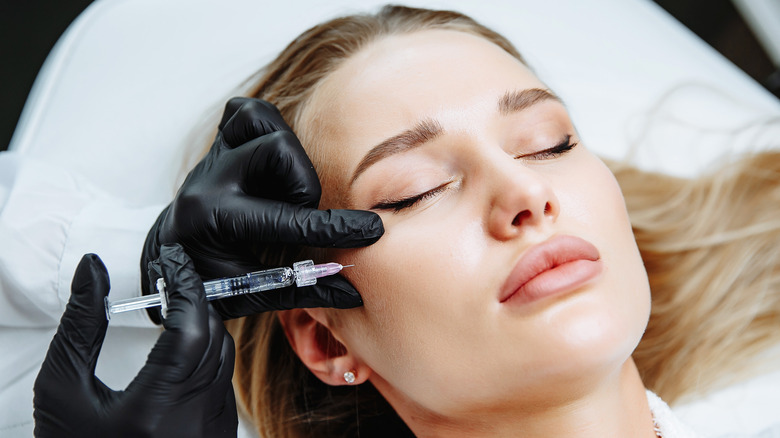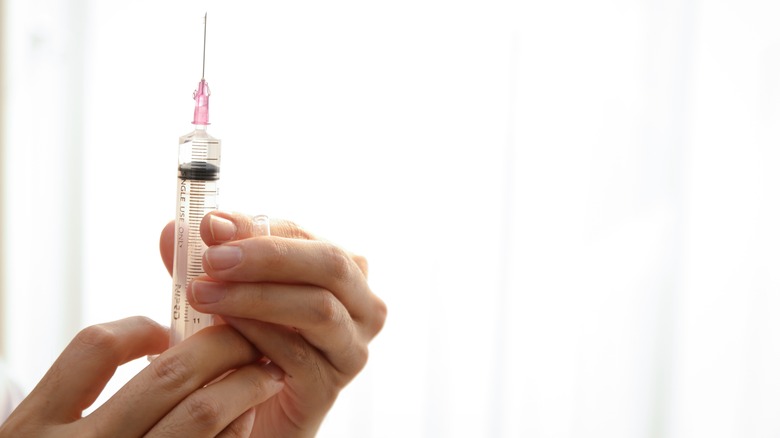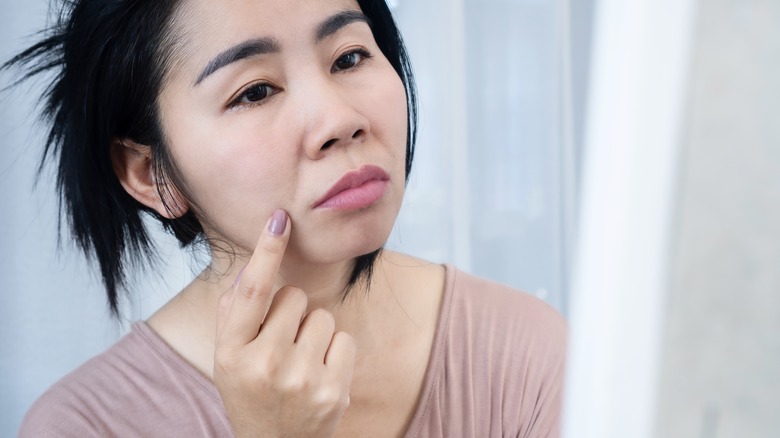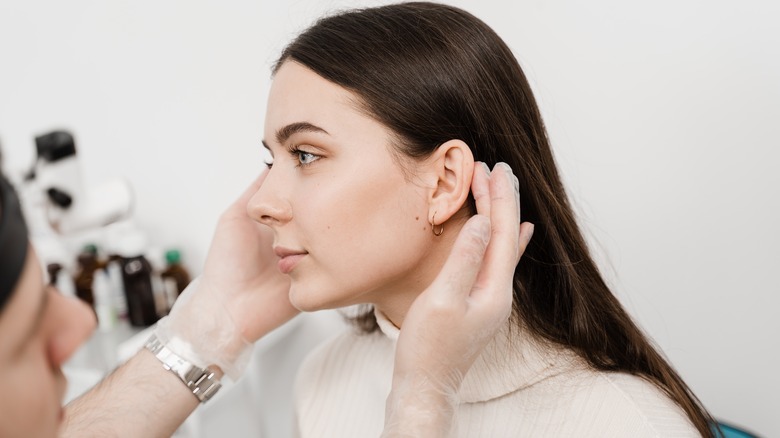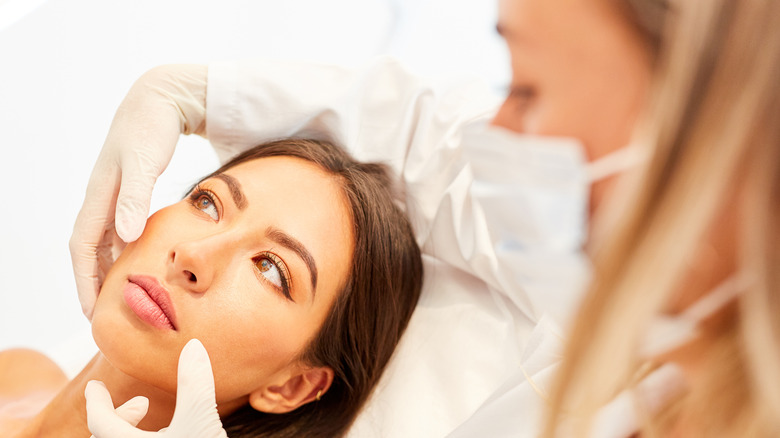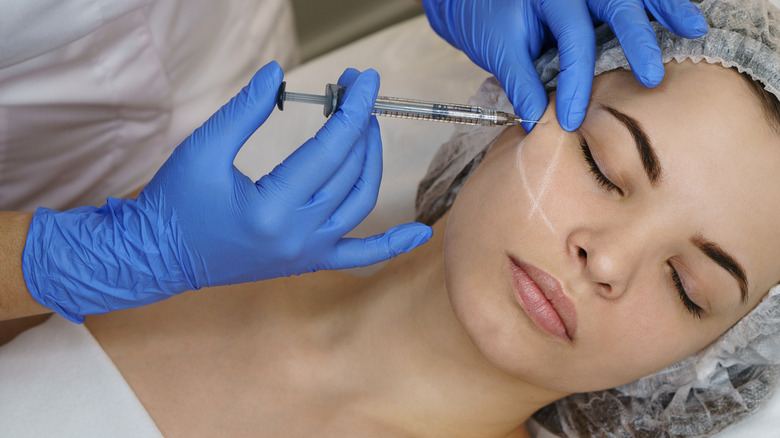Cheek Filler: What You Need To Know Before Committing To The Procedure
Dermal fillers have seen an explosion in popularity since the turn of the century, thanks to online influencers and celebrities like Courtney Cox, Khloe Kardashian, and Kaley Cuoco. Cheek filler, in particular, has gained traction due to its ability to both reverse signs of aging and contour the shape of your face through the use of a simple non-invasive injection procedure, as per Galderma Aesthetics. On the surface, cheek filler can seem like a no-brainer for someone looking to replace lost volume in the cheek or undereye area while also boosting their natural bone structure.
Like any dermal filer, however, cheek filler injections are a medical procedure that can result in unforeseen complications. All elective medical procedures should be carefully researched, and their benefits weighed against their potential consequences before being committed to. If you've been considering cheek filler, consider this your comprehensive guide to deciding whether or not the procedure is right for you.
Most common ingredients in cheek filler
Unlike cheek implants, cheek fillers are not made of solid or semi-solid materials such as silicone. Instead, they offer a lighter, more malleable, natural look and feel to help combat nasolabial fold wrinkles. This is typically achieved through the use of FDA- approved products that contain various forms of hyaluronic acid, a naturally occurring sugar easily absorbed by the body. Some cheek fillers contain other active ingredients, however, including calcium hydroxylapatite, a natural mineral found in bone matter, and Poly-L-lactic acid (PLLA), a manmade material that contains biodegradable plastic beads.
It's essential to understand the difference between these active ingredients so you can choose the best type of cheek implant for your body and lifestyle. Plus, working with an experienced, licensed medical professional can ensure that you are receiving the proper educational materials associated with the type of filler you choose and that your questions can be answered in a way that is tailored to your specific case.
Risks associated with cheek filler
There is no medical procedure that comes without risk. Before you commit to getting cheek filler, make sure you have reviewed and considered the real possibility of the side effects that could potentially occur during or after the procedure. The most common complications associated with dermal fillers are topical reactions at the injection site, including bruising, redness, pain, swelling, and itching or rash, as per the FDA. However, these are not the only potential risks to consider.
Less common complications include allergic reactions to the filler material, nodules under the skin, infection, open or draining wounds, and necrosis. Necrosis (tissue death) is usually associated with a filler being inadvertently injected into a blood vessel. When this occurs, the patient can also experience stroke and/or blindness, which may be permanent. Cheek and other dermal fillers might be commonly seen, but that doesn't mean getting them is a decision that should be made casually or impulsively. Always carefully weigh the risks of any medical procedure against its benefits.
Cheek vs tear trough filler
A common sign of aging that brings people to consider dermal fillers is the hollowing of the eye sockets. When loss of volume around the undereye occurs, it can create a sunken area below the lower eyelids and above the upper cheeks that casts shadows that enhance undereye circles. Many feel that this hollowed, darkened appearance can make them look older than their actual age. One way to address this hollowing is through tear trough filler. Replacing the volume lost around the eyes can temporarily relieve this problem, however, it may not be the best way to address concerns in the lower eye/upper cheek area.
Since the skin of the eye area is very thin and delicate, filler injected into the tear troughs is more likely to move or migrate over time, according to surgeon Dr. Lanna Cheuck. Due to the delicate nature of the area, tear trough filler is generally placed closer to the skin's surface, leading to a more subtle result that will last for about 6-12 months. Cheek filler, in comparison, can be placed on a deeper level, providing more substantial support for the undereye area and leading to more noticeable results that can last significantly longer.
How long does cheek filler last?
If you're considering altering your appearance through cosmetic procedures, it's important to be aware of how long you can expect a procedure to last. Many people are shocked to discover that even surgical procedures like facelifts aren't permanent solutions and will revert over time, as per the Mayo Clinic. Since dermal fillers are some of the least invasive cosmetic procedures on the market, their results are even more temporary.
While fillers in an extremely delicate area such as the tear troughs will typically last less than a year, a slightly more substantial area like the cheeks is likely to get a little more bang for your buck. According to Healthline, properly placed cheek fillers can last up to two years. However, the longevity of your fillers will also depend on which material they're made of, so be sure to thoroughly discuss all your options with your provider.
Migration risk
If social TikTok trends and celebrity cautionary tales are to be believed, migration is a major risk of getting cheek filler. Migration occurs when filler material that was injected into one area — such as the lips or cheeks — spreads or moves to other areas of the face, and it's one reason the filler look has been going out of style in recent years. For example, TikTok/Love Island star Molly-Mae Hague — known for her use of fillers and cosmetic surgery to achieve a major "glow-up" during her time on the app — is just one influencer who publicly underwent a procedure to have her fillers dissolved in 2020.
In reality, migration is rare in filler that was injected correctly. When an area is overfilled, injections aren't spaced properly, or the filled area is manipulated too soon after the procedure, the risk for migration is increased (via KALOS Medical Spa). This is another reason to verify that the practitioner you're considering doing business with is certified by an accredited institution and has ample experience administering the type of cheek filler you're interested in. If migration does occur, according to Skinfidelity, the out-of-place filler can be dissolved. However, it will require additional injections you likely didn't plan on fitting into your budget and can take up to a week to become fully effective.
How painful are cheek filler injections?
Migration and other potential side effects aside, there is one burning question keeping trypanophobes everywhere from pulling the trigger on cheek filler injections: how painful are they? Unlike fillers in more delicate areas such as the lips or tear troughs, cheek fillers are injected very deep under the skin, just on top of the cheekbone, shares Visage. This depth can sound rather intimidating and create an expectation of pain.
Fortunately, practitioners do take measures to make cheek filler procedures comfortable for patients. According to the Cleveland Clinic, topical numbing agents are typically applied before the filler is injected, and many filler mixtures contain an additional numbing agent to address the possibility of pain beneath the skin. While getting filler injections might feel uncomfortable, it should not include any significant pain. If you feel pain during your procedure, you should alert your practitioner right away in case you're experiencing an adverse reaction.
What to expect at a cheek filler appointment
You've weighed all the pros and cons, found a qualified local practitioner, and decided that getting cheek filler is definitely the right move for you. Now, you just have to wait for the big day. What should you expect when the day of your appointment arrives? How should you prepare? First, you should always follow any specific instructions before and after your procedure given to you by your practitioner's office.
Generally, when you arrive at your appointment, your provider will clean the skin of your cheeks and then apply a local numbing agent. Once the skin is numb, several injections will be administered to each cheek. Afterward, a cold pack may be applied for a few minutes to help minimize bruising and swelling after the procedure. Then, you'll be sent home with aftercare instructions. The entire process is likely to be over in about 20 minutes, as per the Cleveland Clinic.
How to find a qualified practitioner
When cheek filler is injected by a provider who isn't properly trained or experienced, the chances of complications skyrocket. Most adverse reactions to dermal fillers take place due to inappropriate injection techniques, poorly chosen filler materials, or misguided aftercare instructions (via Prime Journal). Your best bet for preventing side effects is to take your time finding a practitioner who is not only appropriately certified to administer dermal filler injections but also has an abundance of experience in doing so.
Don't be afraid to ask providers questions about their qualifications. A practitioner who administers filler injections should be a licensed physician, nurse, physician's assistant, or other health professional who has completed a dermal filler training course, according to the American Academy of Facial Esthetics. Once you've verified these qualifications, search online for reviews of the office's filler services. You should never shop around for the cheapest deal when it comes to fillers — invest in the skills of a qualified professional who can give you the results you're looking for. You only get one face; treat it well.
